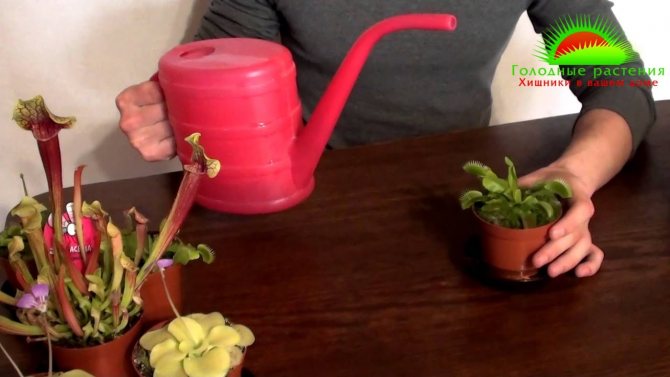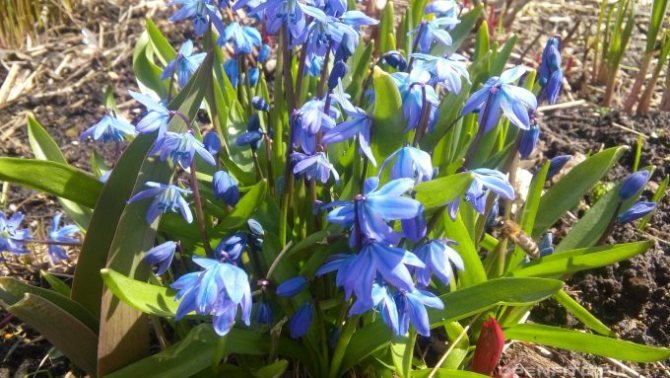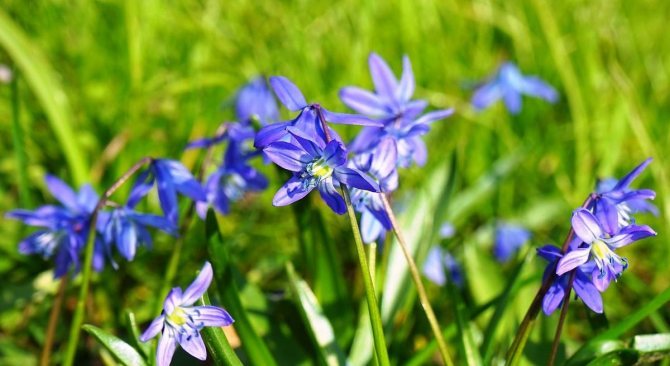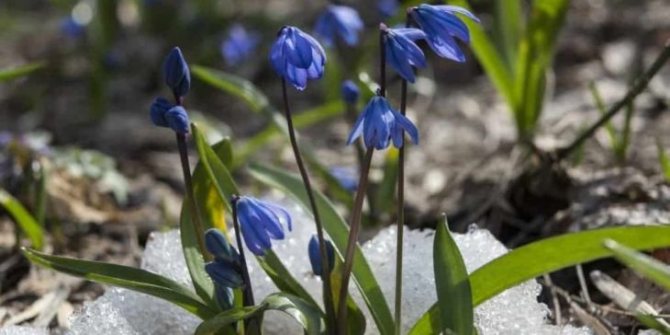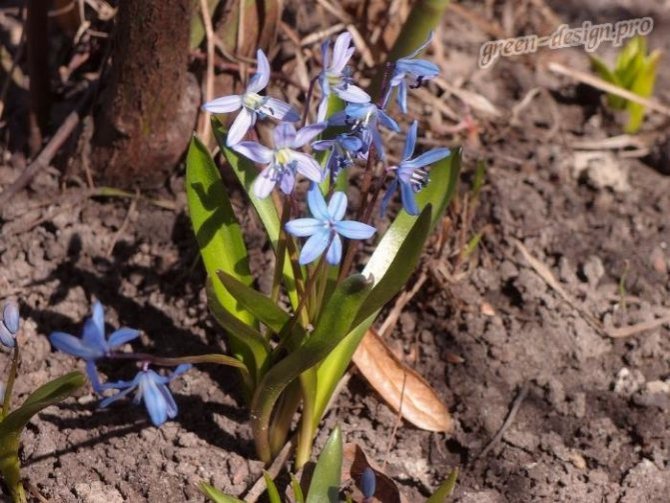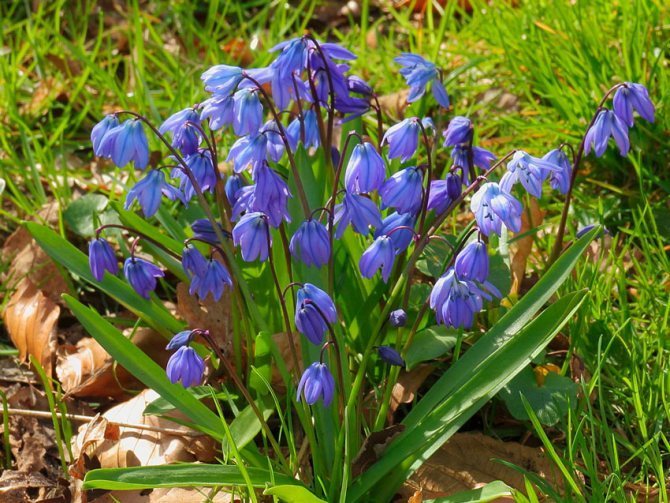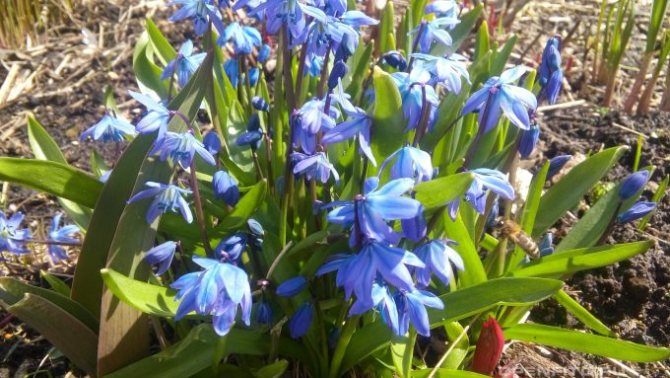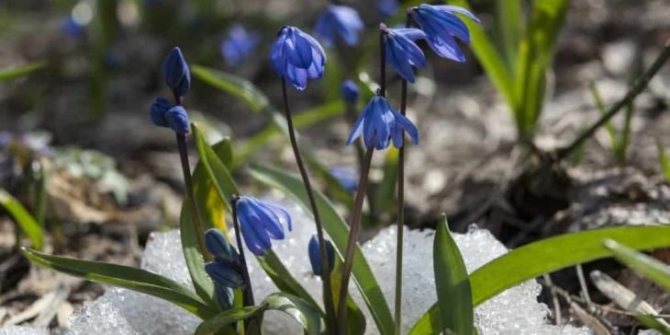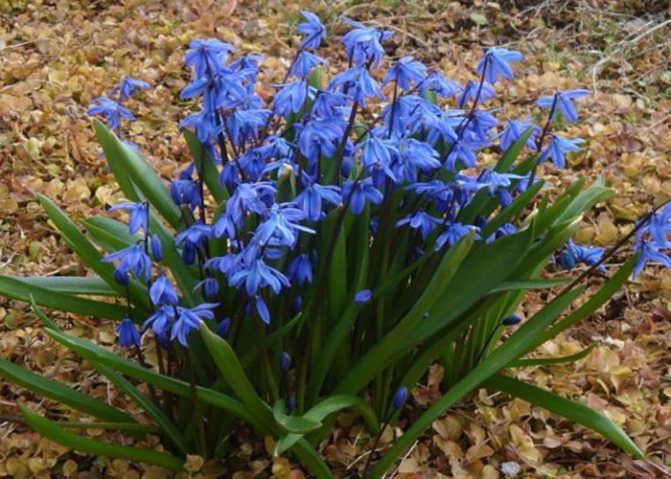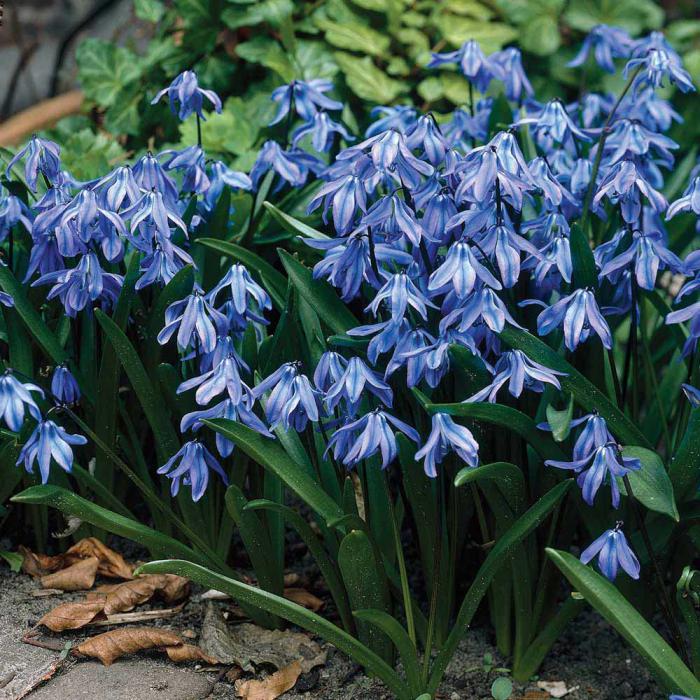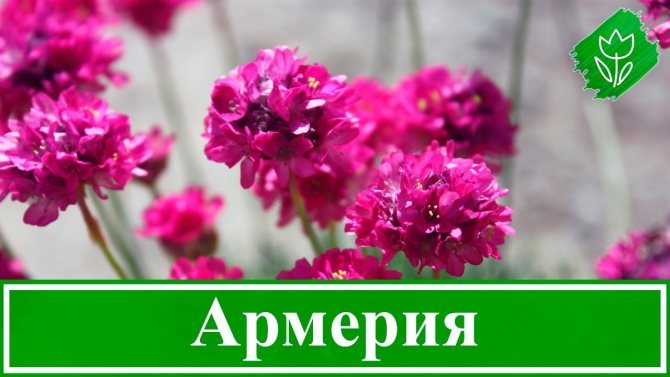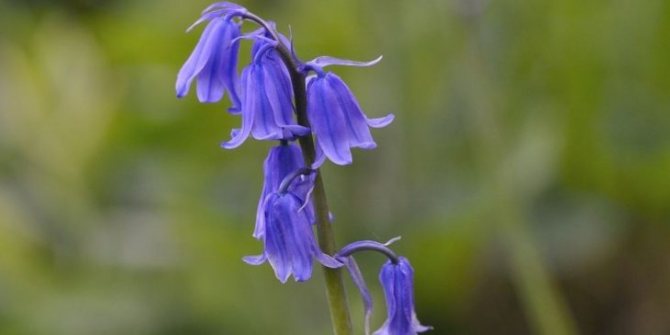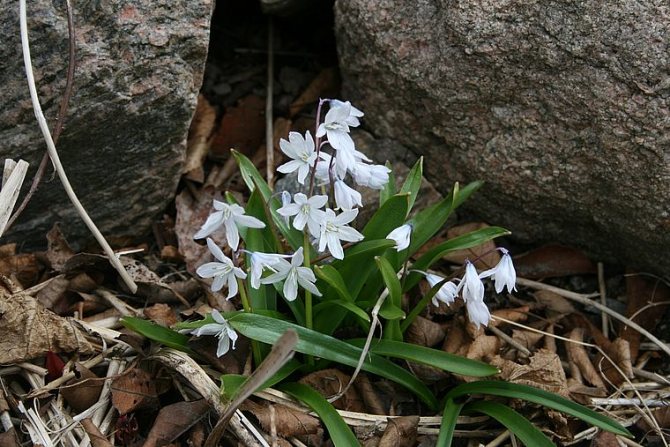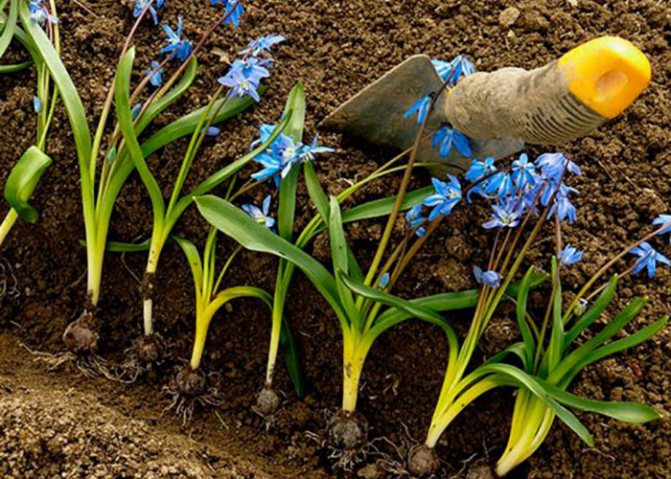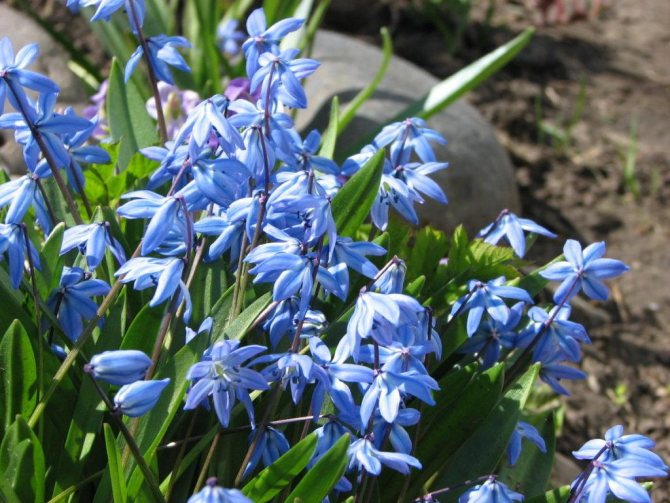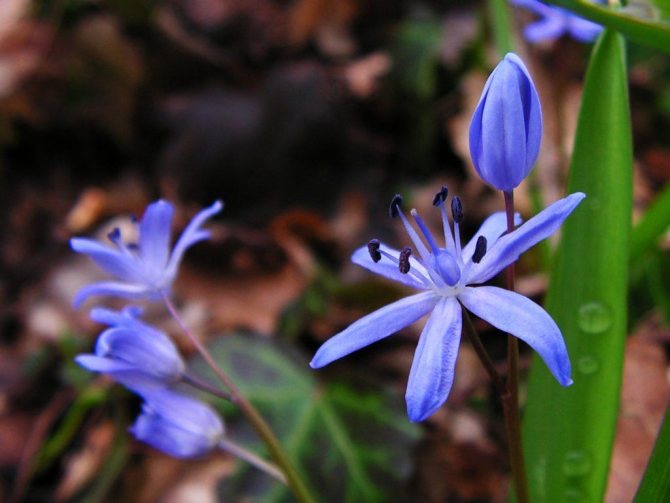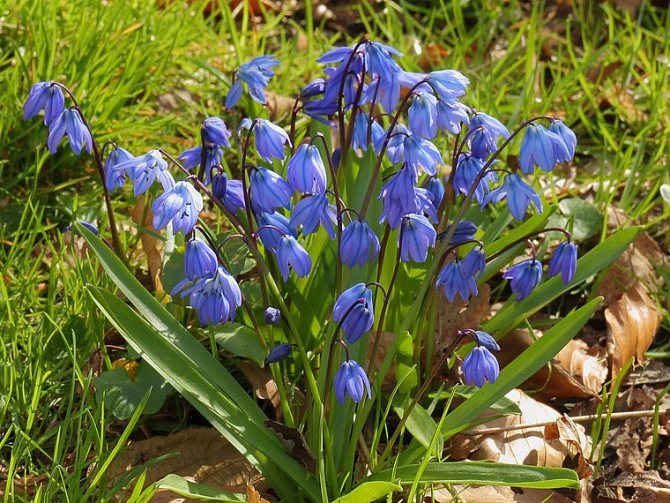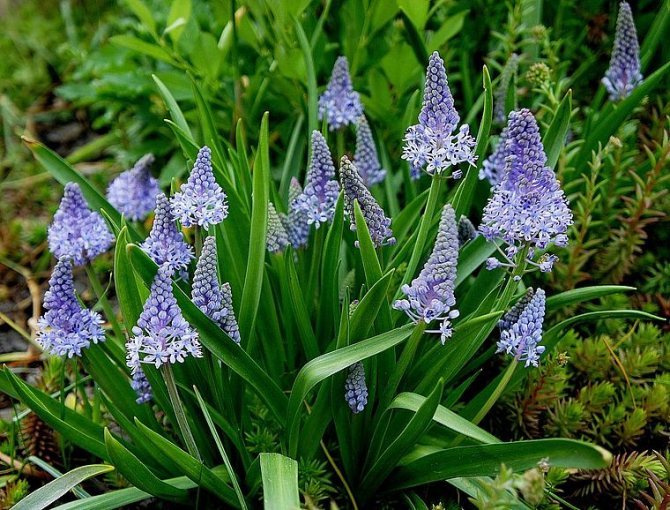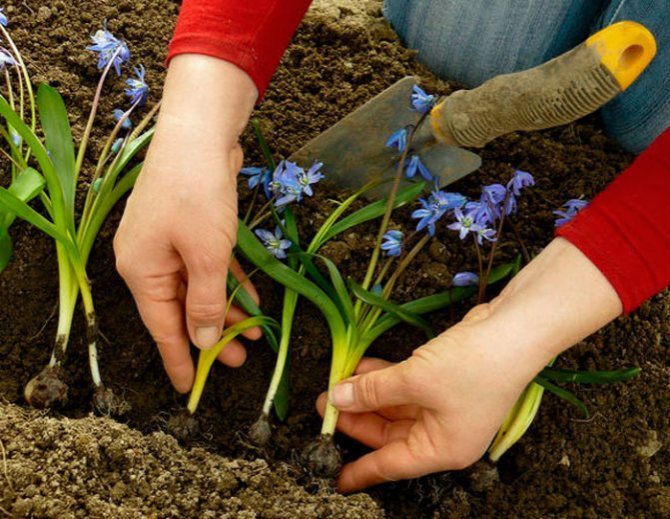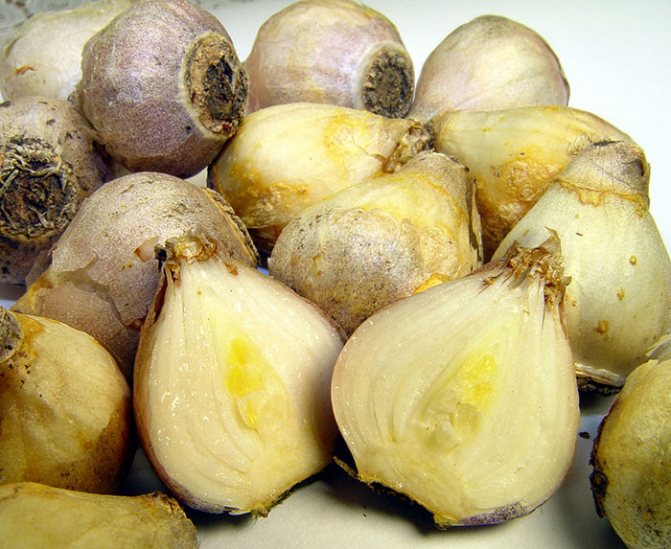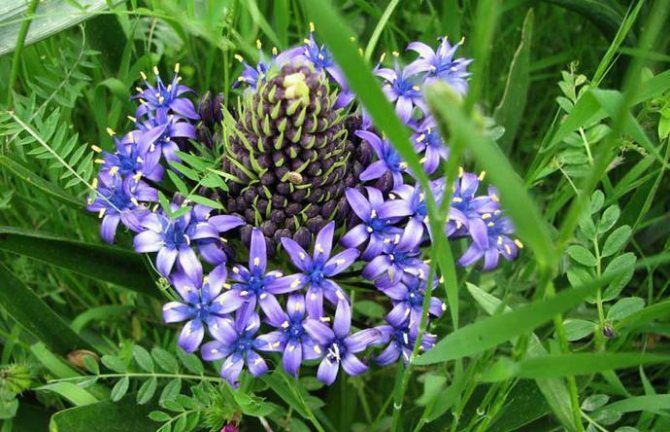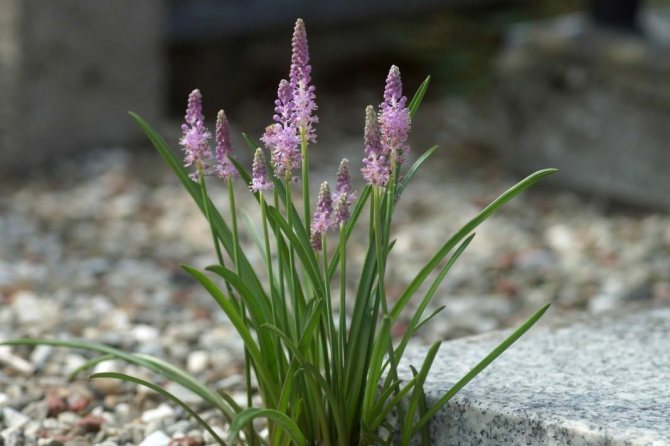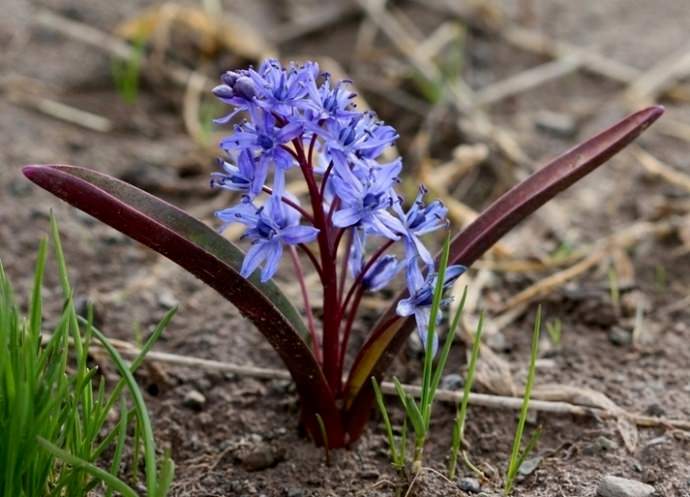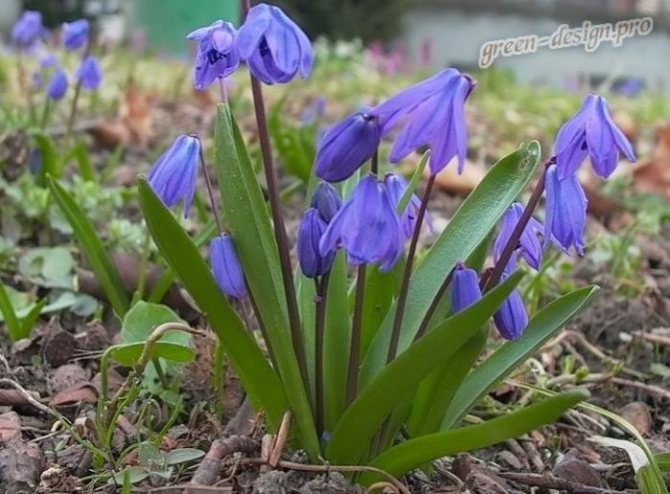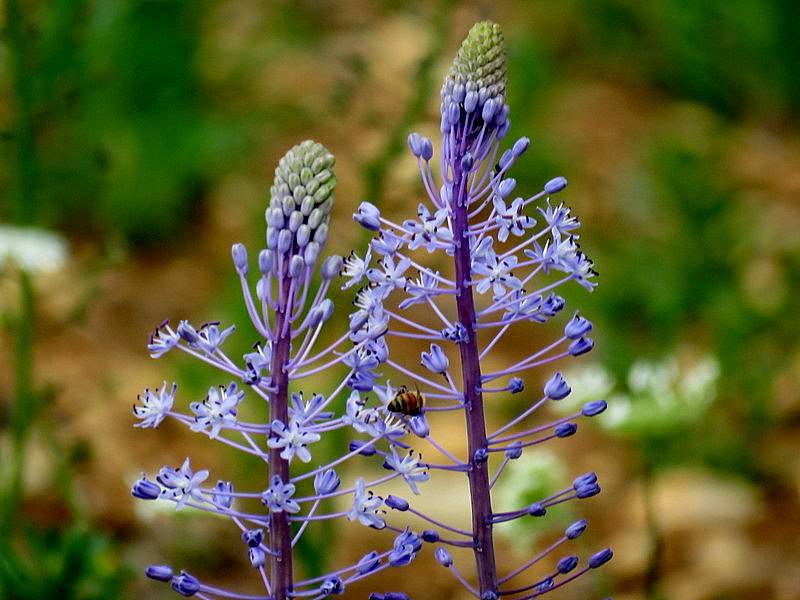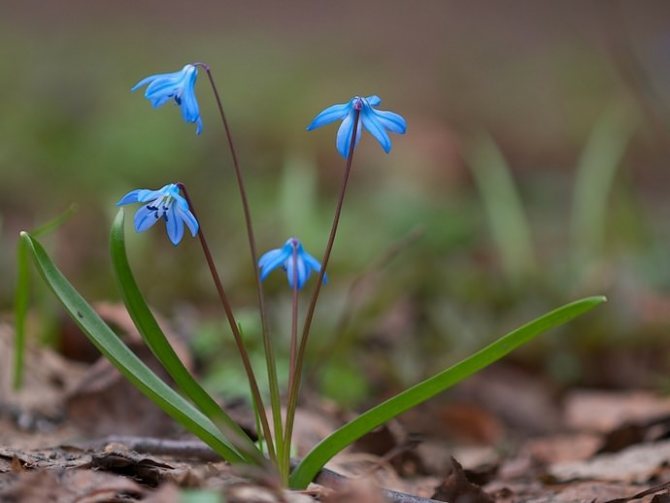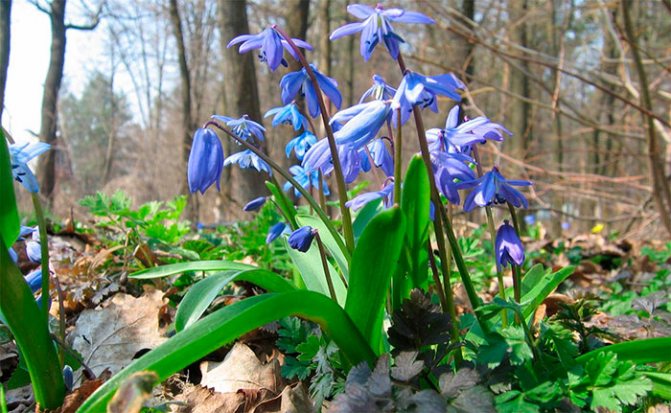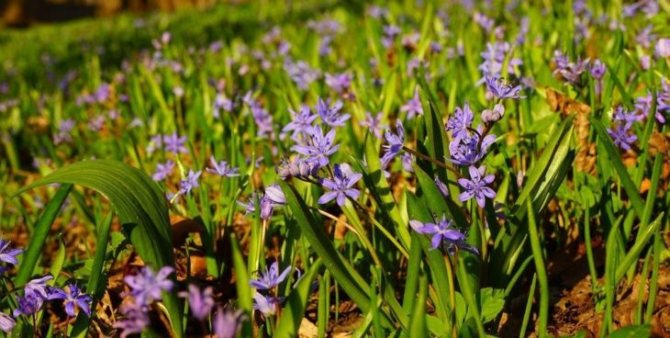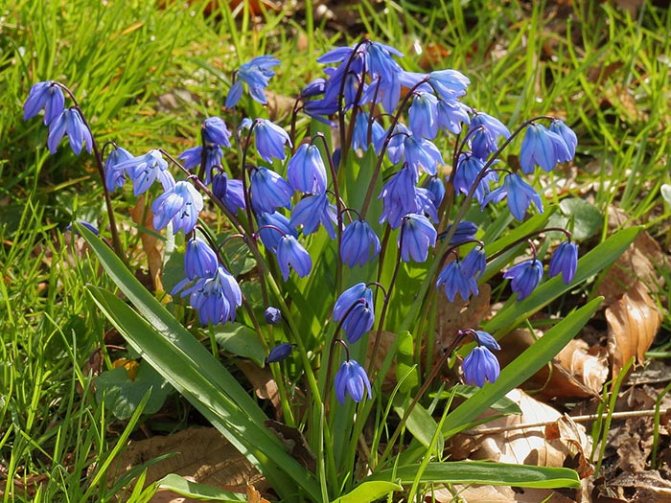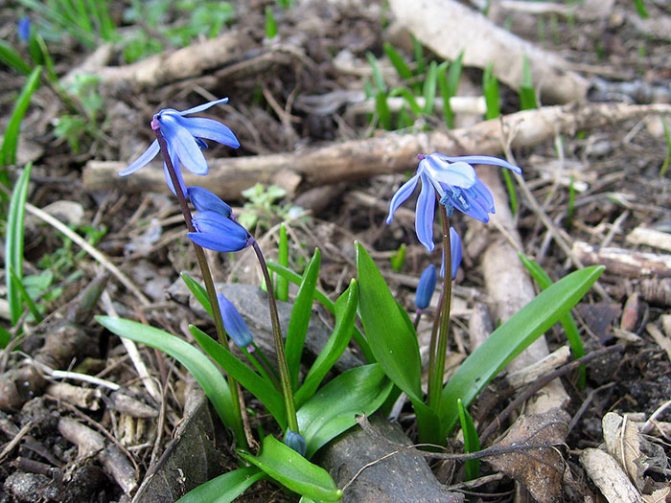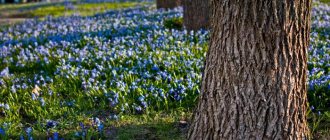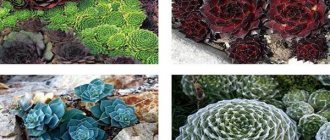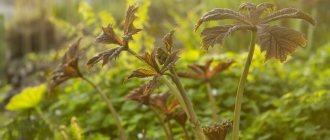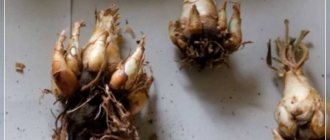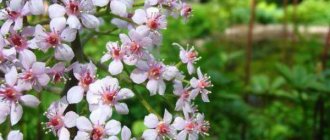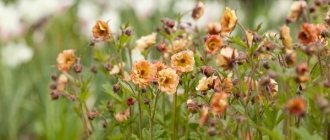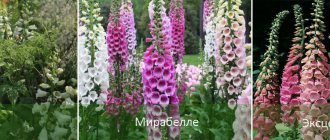Proleska is a perennial bulbous plant of the Asparagus family, although initially experts ranked it as a genus of Liliaceae or Hyacinths. The name Scylla is also encountered, since it is spelled Scilla in Latin. Sometimes this plant is compared or even confused with a snowdrop or forested forest, since it also blooms in early spring.
In the genus of these plants, there are about 90 species that are common in the plains and mountain meadows of Europe, Asia and Africa. The origin of the name is connected with the Greek word "skilla", which means "sea bow".
The scrub itself is distinguished by its decorative appearance and good frost resistance. It is quite resistant to pests and diseases and easily adapts to new conditions.
Characteristics
Scylla is a bulbous perennial. Its bulbs are round or egg-shaped. They are covered with brown, purple or dark gray outer scales.
The leaves are basal, linear. They appear simultaneously with the inflorescences or a little earlier. A feature of the leaves is considered their dependence on the weather: on warm and sunny days, they straighten and stretch towards the sun, and on cold and cloudy days they are pressed to the ground.
The plant has no leaves on the peduncles. The inflorescences have one flower each and grow in the form of a brush. The fruits of the plant are in the form of a box. Inside it are black ovoid seeds.
Scylla is a primrose flower. Its flowering begins in early spring. However, there are varieties that bloom only in autumn.
Botanical description of the screech flower
The Scilla flower is a perennial bulbous plant belonging to the Asparagus family. The genus of the plant has more than 80 species, widespread in European, Asian, African countries.
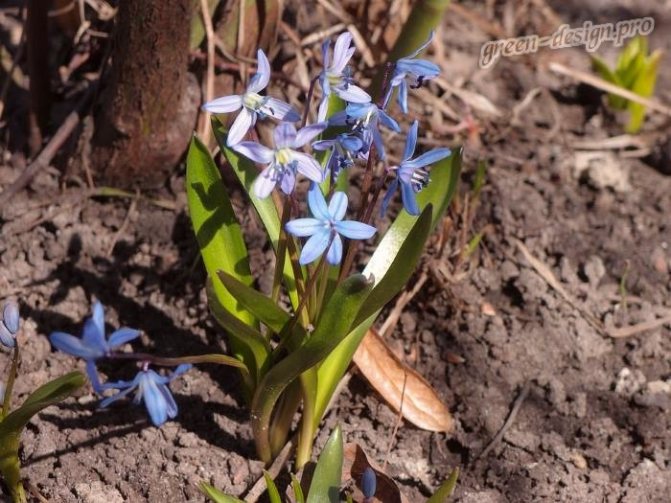
Due to its unpretentiousness, the ability to adapt to the environment, the scrub plant multiplies quickly, practically not susceptible to disease.
Most of the varietal representatives of the plant have a low, medium height (up to 30-35 cm), but there are varieties whose height can reach a meter.
The rich green leaves of the plant are collected in a basal rosette, have an oblong shape. They usually appear on the soil surface at the same time as the flower stalk, or somewhat earlier. Small single flowers are collected in racemose inflorescences located on a long, smooth and strong peduncle. The most common blue woods, but there are varieties with snow-white, purple, pink, blue petals. Most varieties bloom in early spring, but there are also those, the flowering period, which falls in late summer, early autumn.
After flowering, a fruit capsule is formed, which contains small black ovoid seeds.
The bulbs have a round, ovoid shape, the color of the outer shell varies from purple to brown.
Landing
Planting a plant will not be difficult even for a novice gardener. They are usually not planted singly. They are used for rockeries, mixborders, flower beds, alpine slides or rabatoks. They are also often planted around garden trees.
Boarding time
Since the scilla adapts easily to new conditions, it can be transplanted even during flowering.However, for better health of the plant, it is better to transplant them at a certain time. Experienced florists recommend:
- Repot the spruce trees blooming in spring from about mid-June, after the leaf plates die off;
- Transplant those blooming in autumn one month before the formation of peduncles, approximately in August.
Determine the place
The first thing to do is determine the location. The place where the flowers will be planted can be sunny or shaded. This largely depends on the variety and flowering time. The spring ones feel better in the sun, and the autumn ones - in the shade.
Priming
A soil with a rich organic composition, including leaf humus and mineral components, is best suited for a plant. For the full development of flowers, you can mix garden soil with forest soil, since it contains semi-processed tree bark and foliage. The acidity for the plant should be in the range of 6.5-7.0.
How to plant
Make the required number of planting holes. Their size is about 8 cm x 8 cm, and the distance between them is 5-10 cm. Dip the bulb into the hole by 7-8 cm and cover with prepared nutritious soil mixture.
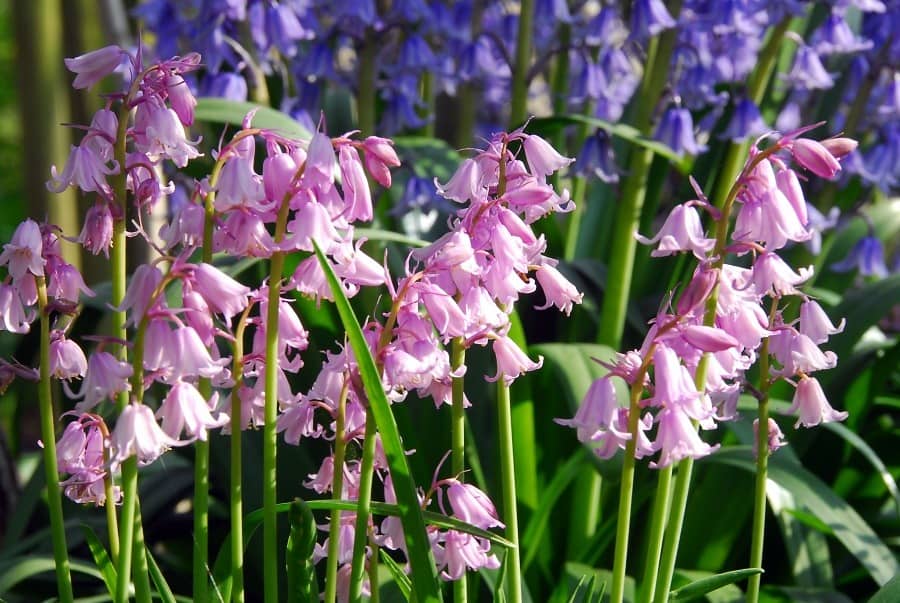

4 distillation at home
4.1 How to get rid of a line
If you wish, you can get a blooming bunch of woods for any desired holiday. Siberian and two-leaved woods are best suited for forcing. When forcing indoors, the bulbs are planted in October in fresh soil so that they are only slightly covered with a substrate.
For keeping at home, pots with sufficiently large drainage holes are selected and the first layer is laid with a moisture-removing material - broken brick, expanded clay. Since the root system of the forest canopy has a rather modest size, it is enough to pick up a shallow and wide bowl. Fill the pot 2/3 with the substrate and begin planting the bulbs.
It is worth retreating from the edges of the pot by 2 cm and leaving about the same distance between the bulbs. When grown in pots, the bulbs may not be deeply buried - it is enough to cover them with a layer of soil 1 to 3 cm thick, depending on the size of the bulbs. In order to avoid decay of plants, you can put a small layer of river sand directly under the bulbs themselves and surround the bulbs around the perimeter with it.
Place the plantings in a dark and cool room - for example, in a cellar with a temperature of 3 - 5 ° C. Plants should be removed 3 weeks before the desired flowering date. At the same time, the air temperature is raised to 12 - 15 ° C, while also putting it in the dark or just covering the bowl with dark material. After a week, the shelter is removed or the pot is taken out into the light and the temperature is raised a little more - up to 15 - 18 ° C.
Interestingly, a properly carried out transplant does not harm the plants at all, so the overgrowth can be transplanted even with flowers. Unfortunately, many varieties will not bud from year to year when grown in a pot - these flowers should be planted outdoors after forcing.
↑ Upward,
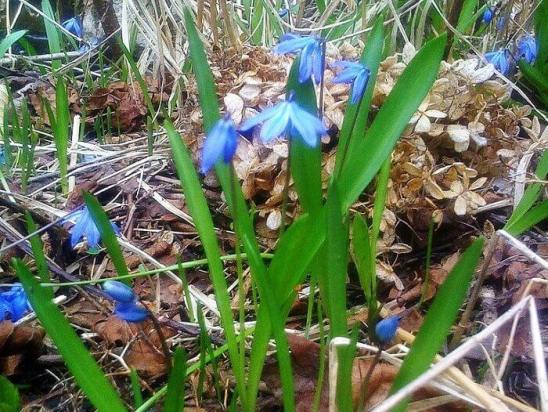

4.2 Temperature conditions
Proleske is suitable for moderately cool content at temperatures up to 15 ° C, it promotes abundant and long flowering. When kept warm, flowering may not occur at all, and too warm content will lead to a significant reduction in flowering time. When grown outdoors without shelter, Scylla bulbs can survive down to -15 ° C.
↑ Up,
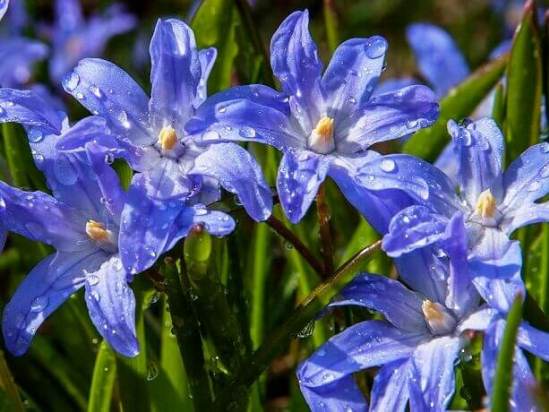

4.3 Lighting
Scylla is not demanding on lighting conditions - it can be successfully grown both in a brightly lit place and in partial shade. The most suitable for the flower will be windows with an east or west orientation.
↑ Up,
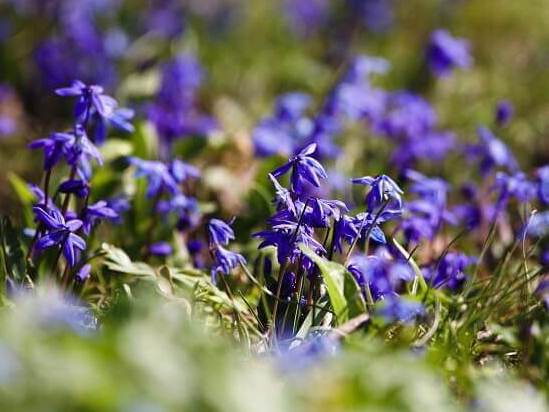

4.4 How to care for Proleska
Proleski varieties have been bred that can be grown indoors for many years, but most varieties bloom in culture for 1 season, after which the bulbs are dug up and stored in a cool place for several months - until signs of new growth appear. Such plants are planted in open ground so that they feed nutrients for 2 - 3 years and only after that they can be used again for forcing. After flowering, the leaves will turn yellow and dry - do not remove them, they continue to nourish the bulb. It is appropriate to pinch the wilting buds together with the peduncles - this way the plants will not waste their energy on the formation of seeds and the bulbs will receive additional nutrition.
↑ Up,


4.5 Soil
Proleska thrives in any soil with good drainage. Substrates rich in organic materials are preferred - for example, mixtures based on leaf and sod humus, as well as peat. To increase the moisture transmission capacity and so that the earth does not cake, but remains loose, coarse river sand, perlite or vermiculite is mixed into it. The soil pH level should be close to neutral - for example, in the region of 6.5 - 7.0. The soil should easily allow air to reach the plant roots, allowing them to breathe.
4.6 Top dressing
With the appearance of sprouts, they begin to feed the forest forest with complex fertilizers for flowering plants. Enough 2 - 3 dressings per season. The use of nitrogen fertilizers or large amounts of organic matter can lead to abundant leaf growth and negatively affect flowering. Since the bulbs contain a certain supply of nutrients, it is better to underfeed the plants - when applied, fertilizers should be diluted to half the dose recommended on the package.
↑ Up,
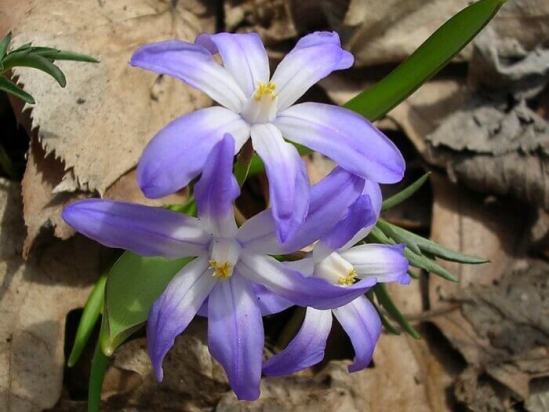

4.7 Purpose
Scylla can be used as a forcing plant. Flowering usually occurs within 4 to 5 months after planting. For distillation, only the largest and healthiest-looking bulbs are selected, disinfected in a weak solution of potassium permanganate and planted in a nutritious moist soil. Plants are also often used in delicate spring bouquets - they can retain their attractiveness for a long time in a vase of water.
4.8 Air humidity
Maintain high humidity by placing the spill container on a pallet of damp pebbles, or use a room humidifier. Spraying can be carried out, however, during the flowering period, getting on flowers and buds, moisture can spoil their appearance.
↑ Up,


4.9 Soil moisture
The scrub requires abundant and regular watering during the growing season, but it is worth increasing them gradually - as it grows. After planting the bulbs, but before the first leaves appear, the soil is kept slightly moist. As the green mass develops, the frequency of watering is gradually increased. After flowering, watering is gradually reduced and when the entire ground part of the bulb dies off, they should again be in barely moist soil.
↑ Up,
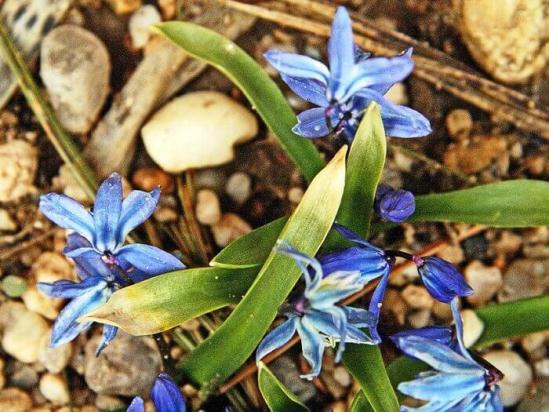

4.10 Pests and diseases
Decay with frequent watering in autumn and winter or insufficient drainage. Humid and stagnant air sometimes leads to gray mold. Achelenchoides is a disease characteristic of bulbous plants, which is expressed in the fact that the bulbs on the outside acquire a brown hue, and ring rot appears on the surface. Plants affected by the disease are destroyed.
A spider mite may appear from harmful insects when kept at home. When grown in the open field, woodworm bulbs may suit the taste of mice, onion hoverflies.
You may also be interested in:
- Poultry garden - photo, planting and care in the open field, description of the plant, medicinal properties, home care, application. flowering time, varieties and species, soil for growing in a pot, transplanting
- A hellebore - a photo of a flower, use in medicine, planting grass and care in the open field, medicinal properties, a description of the plant - what it looks like, growing from seeds, caring for seedlings, shrub flowering time, diseases and pests
- Saffron or crocus - planting and care, flowering, growing in the open field, a description of when to plant, propagation of domestic crocuses with seeds, when and how to replant
- Primrose or primrose - photo, caring for a perennial plant, planting in open ground, home care, varieties, flowering, growing from seeds, when to transplant a plant
4.11 Note, Interesting Facts
It is interesting that in bad weather - when it is windy or it is raining, the leaves of the scylla adhere to the ground, and on fine sunny days they are located almost vertically. Unfortunately, earlier flowering attracted increased attention to the plants - they were often used in spring bouquets, as a result, some types of tree forest are now listed in the Red Book.
Hydroponics.
Caring for a creeper in the garden
Scylla is characterized by its unpretentiousness, especially when compared with other early flowers.
To create favorable conditions, the plant needs watering, weeding and loosening of the soil. This is usually done in combination. When the soil of the plant dries up, it needs to be watered, loosened the surface (about 2-2.5 cm), and at the same time remove all weeds. These procedures are best done in the morning. It is important to water to the very roots and make sure that no water gets to the surface of the plant. This can affect the appearance of the flower. To reduce the amount of watering and weeding, mulch can be added to the surface of the ground around the woodland.
The time to feed the plants also depends on their flowering time. Spring-flowering Scyllas are fertilized with complex fertilizers in early spring, and autumn-flowering ones - in autumn. To do this, you can use a drug such as Nitrofoska. After feeding, the flowering will become even more magnificent. Complex fertilizers should be chosen with the addition of elements such as calcium, iron, copper and magnesium.
Growing a scilla for the New Year and March 8
Scylla planting for the holiday is carried out depending on when you need to receive flowers. The period of calm state of the bulbs is 8 weeks. Therefore, if you need to drive out the plant for the New Year, then plant the bulbs in September. If by March 8 - in the month of November.
The bulbs are planted in pots with a diameter of about 10-15 cm. They are planted in 2-3 pieces. Then the pots are removed in a dark, cool place (from 0 to +5).
Before you need to get flowers, in about 2-3 weeks, the pots are taken out into the light and warm. A place for them should be well-lit and warm, but not hot (up to +15 - +18 degrees). Moderate watering is necessary: the ground should not be excessively wet, but it should not be allowed to dry out. In a week, leaves will appear, and soon the scilla will bloom.
Scylla is a wonderful, gentle, unpretentious flower. Blue flowers will delight when everything is still gloomy and gray around. The leaves on the trees have not yet blossomed, and even the snow has not completely melted, and the scrub is already blooming and captivating with its honey aroma.
Reproduction
For these purposes, seeds or children are used.
- Reproduction by daughter bulbs has already been described above, in the section on transplantation. The plant is dug up, the children are separated and immediately seated in the holes;
- To grow woodlands from seeds, they must first be harvested. At the end of June, seed boxes turn yellow and crack. At this moment, they need to be collected, seeds removed from them and immediately sown in open ground. This is a fairly long way of reproduction. The seeds have a low germination rate. Plants that grow from seeds will bloom only after 3-4 years, and can be planted only after 5 years.
Outdoor cultivation
Siberian sprouts can be planted in rockeries or mixboxers, on curbs or alpine slides.Plants are planted in open ground in the second half of June, after the leaves die off. Species that bloom in autumn are planted at the end of summer, a month before the appearance of peduncles.
The spruce flower can grow in partial shade, but it is better to choose an area with good lighting for it. Spring species and varieties are more light-loving.
The soil should be nutritious, containing organic matter and mineral fertilizers. Before planting bushes, garden soil is mixed with tree bark and semi-decayed foliage. The result will be a soil similar to that in a forest, and Siberian scrub will grow well in your garden. The plant does not like acidic and swampy soils, therefore the site should be with moderately moist soil.
Pests and diseases
Despite all its resistance to diseases and pests, there are cases of infection:
- Gray rot - affects the leaves and tops of the bulbs. The plant begins to rot, turn yellow and may completely die. Sick woodlands are dug up and burned. If the bulbs are infected in storage, the affected areas are removed and the wounds are sprinkled with wood ash.
- Achelenhoides - affects almost the entire plant. The bulb begins to rot, and the upper part of the scilla wilts and does not develop. Diseased flowers should be dug up and burned.
- Bulb rot - appears due to fungal infections and develops rapidly with high humidity. At the bush, the leaves begin to turn very yellow, the flowers wither, and then the whole bulb is affected.
- Mouse-like rodents - for voles and house mice, woodworm bulbs are one of the delicacies, and in spring they can even eat shoots. To combat them, a groove is dug around the site, where the bait with the poison is buried.
- Root bulb mite - pests attack the bulb, causing the plant to rot and dry out. To combat pests, the scilla is sprayed with an insectoacaricide.
Diseases, plant pests
The greatest danger to the scilla is represented by the beetle and bear larvae. They feed on bulbs, crippling them, from which plants wither and die. Damaged bulbs are often attacked by onion fly and onion hoverfly, which eat away the soft core, leaving the plant without nutrients. The fight against them consists in regular treatment with insecticidal preparations, digging up the soil in the fall in search of buried larvae of beetles and bears. In the spring, repellent infusions of tobacco, garlic and onion peels are used.
Due to an excess of moisture, the bulbs can be affected by mold rot, gray mold, mold fungi. It should be remembered that the blueberry does not like excessive amounts of water. During the rainy season, cover the plants to prevent excess moisture. For better drainage, before planting in a flower bed, it is worth adding expanded clay or small broken bricks, and treat the bulbs with a slightly pink solution of potassium permanganate before planting.
If you wisely choose the planting site and soil, carry out timely watering and thinning of the beds, the spill will delight the eye on the alpine hills from the very first warm days, indicating the arrival of spring and the awakening of nature. In flower arrangements, it looks good with daffodils, crocuses and other white and yellow primroses. With proper care, you can extend the flowering of the forest for up to two months.
Popular: Picky Takka for exotic flower lovers
Now read:
- Varieties, planting and care of perennial rudbeckia
- A persistent, large harvest of cucumbers after planting for seedlings
- Hanging flower art with ampel plants
- Variety of shapes and colors Calathea from the Marantov family
About
Chief agronomist of the Limited Liability Company "Association of Peasant (Farming) Farms" Kuznetsovskaya "", Ilovlinsky District of the Volgograd Region.
Varieties
There are a lot of species and varieties of scilla bred. Many of them are successfully cultivated by gardeners on their plots. The most popular are:
Scilla hispanica
Also there are names of this species as bell-shaped scilla or Spanish endymion. This species comes from Spain, Portugal and the south of France. It grows in height by 20-30 cm. Inflorescences in the form of a brush, consisting of 5-10 flowers in the form of bells, grow on the peduncles. They come in shades of pink, white or blue. They bloom for about 2 weeks, starting at the end of May. For the winter, this species is recommended to be covered with fallen leaves or spruce branches. Popular varieties of the bell-shaped scilla are:
- Rosabella;
- La Grandes;
- Sky blue;
- Rose Queen;
- Blue Queen;
- Mont Everest;
- Dainty Maid et al.
Scilla bifolia
The second name is two-leaved scrub. Under natural conditions, it can be found in the Mediterranean, the Caucasus and the Crimea. Compared to other species, this one is shorter and more lush. Its height is no more than 15 cm. Inflorescences with pink or white flowers on the peduncle. They have a harsh but pleasant scent. Each inflorescence has 15 flowers. Bloom for 2 weeks from mid-April. Garden variety bifolia var. Purpurea is characterized by a purple tinge of flowers.
Scilla autumnalis
In the wild, it is found in Asia Minor, the Mediterranean and North Africa. One bush grows up to 5 peduncles 15-20 cm. The flowers are violet-red or light lilac. Flowering begins in late July or early August.
Siberian beetle (Scilla sibirica)
This species is Siberian in name only. You cannot find it in Siberia, but it is found in the Crimea, the Caucasus, southern Europe and the European part of Russia. The flowers on the peduncles are blue and contain nectar. Its peculiarity is in the time of opening and closing. Flowers bloom at 10 am and close at 4 pm. The species has 3 subspecies:
- Caucasian;
- Armenian;
- Siberian.
Proleska is a beautiful flower that pleases with its tenderness and unpretentiousness. In early spring, when everyone is so tired of the long winter, the scilla is already beginning to bloom and give its lightness and honey aroma.
Rare species
On the open market, the following types of scilla are quite rare. Basically, they can only be ordered from specialized flower catalogs:
- Spanish. Bulbous perennial with a strong stem system. In active growth, it reaches a height of 40-60 cm. It grows rapidly, filling flower beds and a free garden perimeter. Originally from Portugal. Flowers distinctly resemble bells, collected in a brush and evenly distributed along the length of the stem.
- Natalskaya. Tall perennial (up to 120 cm), native to South Africa. Fleshy tight stems are strewn with violet-blue, white-pink and blue flowers with a diameter of 1.5-2 cm.Leaves in an amount of 4-8 pieces during flowering inhibit their growth, remaining at the level of 15-20 cm, and then reach a length of 40- 60 cm.
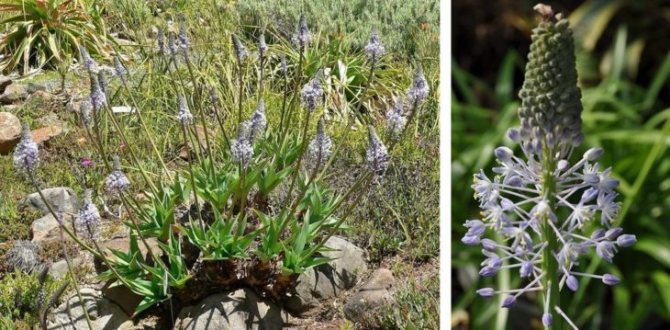

Spanish
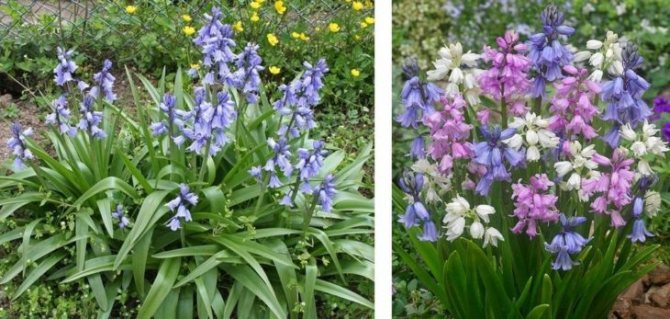

Natalskaya

